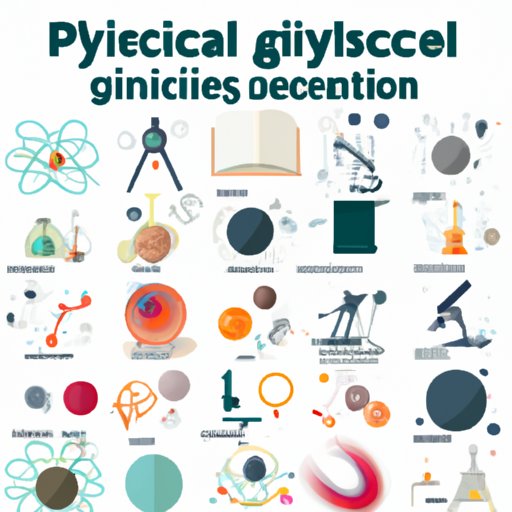
I. Introduction
Physical sciences have always been a fundamental part of human curiosity and exploration. The natural world around us is full of mysteries, and physical sciences offer a way to solve them. In this article, we will explore the basics of physical sciences, their importance, and how they help us understand the natural world.
II. The Basics of Physical Sciences: Understanding the Branches and Concepts Behind Our Natural World
Physical sciences involve the study of non-living parts of the natural world, including matter, energy, and their interactions. The study of physical science is divided into several branches, including physics, chemistry, geology, meteorology, and astronomy. Physics explores the fundamental principles governing matter and energy, while chemistry deals with the properties and interactions of matter. Astronomy focuses on the study of stars, planets, and other celestial objects.
The study of physical sciences is crucial to solving many problems in our daily lives, from tackling environmental challenges to developing new technologies and materials to advance our society.
III. Exploring the Foundations of Physics, Chemistry, and Astronomy in the Physical Sciences
The fundamental ideas of physics include energy, motion, and force. Basic physics concepts include electricity, gravity, mechanics, and thermodynamics, and these principles are used in many applied fields such as engineering and medicine. Chemistry examines the interactions between atoms and molecules and provides an essential foundation for the functioning of living organisms. Astronomy includes the study of galaxies, stars, and planets and their interactions with each other and their environment.
One common aspect of all physical sciences is the scientific method, which is a systematic approach to acquiring knowledge about the natural world. Experimentation, observation, and analysis are the fundamental tenets of the scientific method, and they enable us to gain knowledge about the natural world by testing hypotheses and theories.
IV. From Atoms to Galaxies: Unpacking the Fascinating Field of Physical Sciences
Physical sciences encompass a wide range of fascinating topics, from the structure of molecules to the behavior of stars. The microscopic world of atoms and molecules is explored in chemistry, and topics such as the periodic table, chemical reactions, and elements are studied. Physics covers a broad range of topics, such as dynamics, light, waves, and electromagnetism, while astronomy examines the vast universe and focuses on topics such as the Big Bang theory, cosmology, and black holes.
The interdisciplinary nature of physical sciences enables us to study the world holistically. Research in one branch often overlaps with discoveries in another branch, leading to new insights and greater understanding of the natural world.
V. The Importance of Physical Sciences in Today’s Modern World: A Comprehensive Guide
The impact of physical sciences is pervasive in our daily lives, from powering our homes through electricity, to tracking weather patterns, to creating life-saving medical technologies. The principles of physical sciences play a crucial role in many modern fields such as materials science, biotechnology, and renewable energy.
Materials science is a field that seeks to develop new materials with desired properties for various applications. Physical sciences have contributed to the development of new materials such as polymers, composites, and nanomaterials with a wide range of applications, from electronics to aerospace to healthcare.
Physical sciences have also revolutionized healthcare. Technologies such as X-rays, MRI scans, and ultrasound imaging are used to diagnose and treat various medical conditions. Physics has enabled the creation of life-saving devices such as pacemakers, while chemistry’s contribution to medication development has improved the quality of life for millions of people around the world.
VI. Breaking Down the Complexities of Physical Sciences: Making Science Accessible for All
Despite the importance of physical sciences, understanding them can be challenging. Common misconceptions about various concepts and the fear of math and equations may deter individuals from pursuing physical sciences. However, making science accessible and interesting can help to overcome this challenge.
There are many resources available online for individuals interested in exploring physical sciences, such as podcasts, videos, and online courses. Joining online communities can help individuals connect with like-minded individuals and share knowledge and insights.
VII. Conclusion
Physical sciences offer a way to better understand the natural world around us and help to solve many real-world problems. The interdisciplinary nature of physical sciences allows us to explore the world holistically and is crucial to advancing our society.
Despite the challenges of understanding physical sciences, there are many resources available to help anyone get started. By making physical sciences accessible and interesting to everyone, we can ensure a better future for generations to come.




